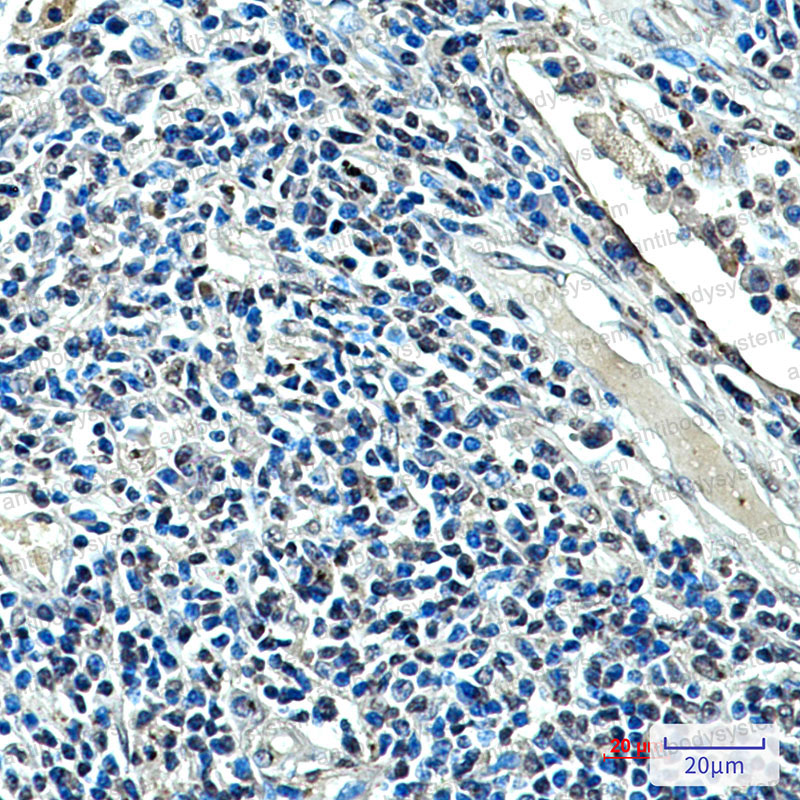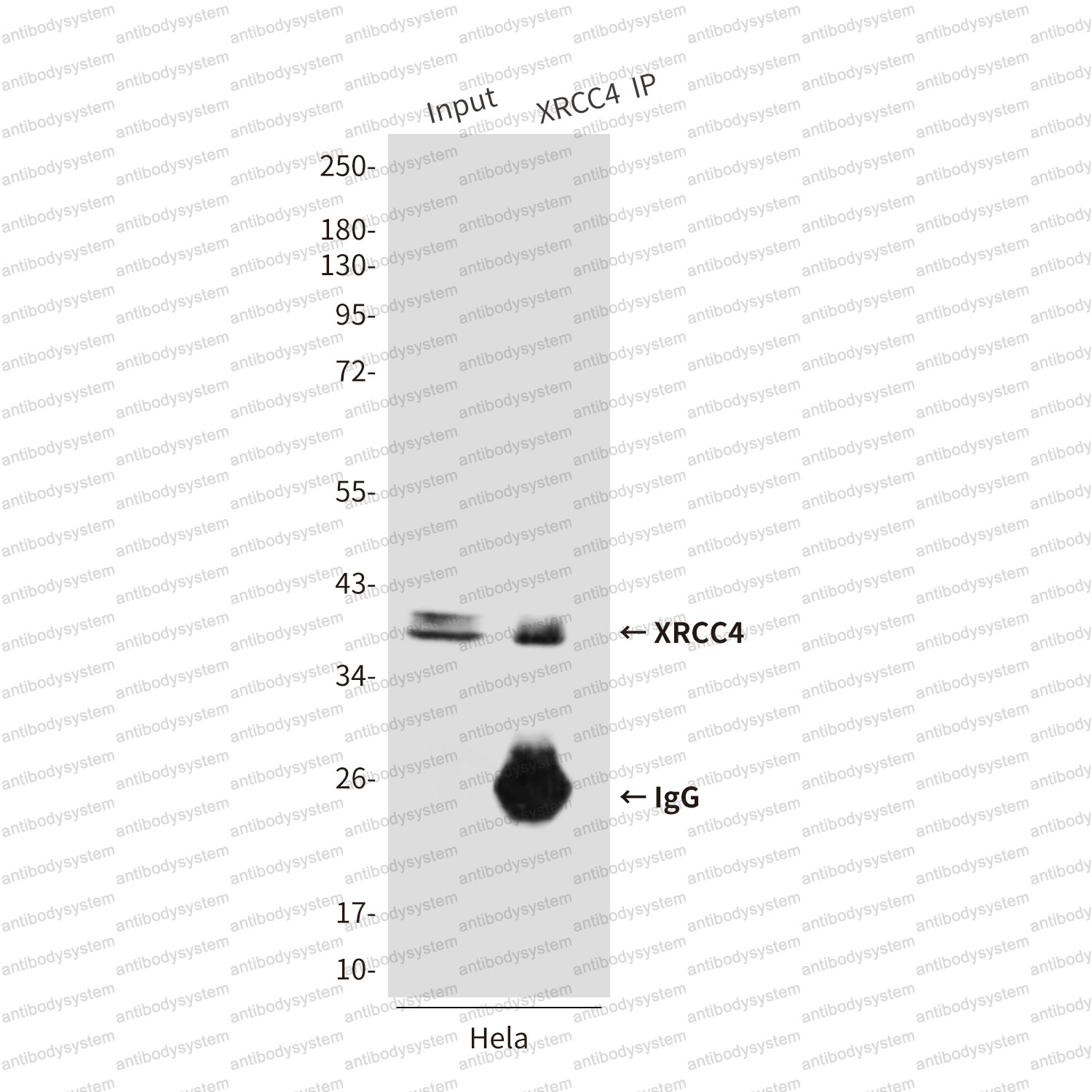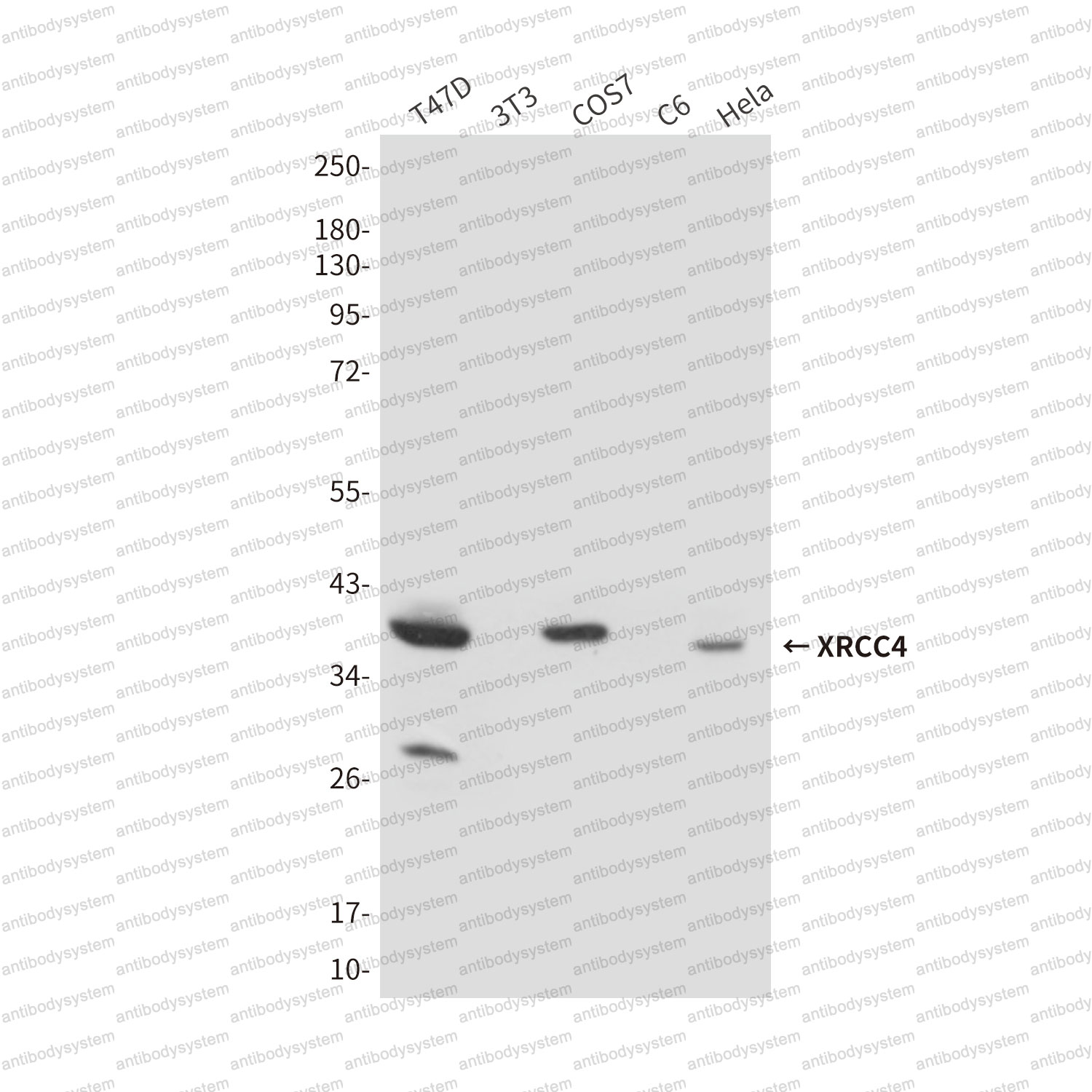Catalog No.
RHG52501
Species reactivity
Human, Mouse, Rat
Host species
Mouse
Isotype
IgG1
Clonality
Monoclonal
Tested applications
IF: 1:50-1:200, IHC: 1:50-1:100, IP: 1:20, WB: 1:500-1:1000
Target
DNA repair protein XRCC4, X-ray repair cross-complementing protein 4, XRCC4
Concentration
1 mg/ml
Endotoxin level
Please contact with the lab for this information.
Purity
>95% as determined by SDS-PAGE.
Purification
Protein A/G purified from cell culture supernatant.
Accession
Q13426
Applications
IF, IHC, IP, WB
Form
Liquid
Storage buffer
0.01M PBS, pH 7.4, 0.5% BSA, 0.05% Sodium Azide and 50% Glycerol.
Stability and Storage
Use a manual defrost freezer and avoid repeated freeze-thaw cycles. Store at 4°C short term (1-2 weeks). Store at -20°C 12 months. Store at -80°C long term.
Clone ID
R3S47
X-ray scattering reveals disordered linkers and dynamic interfaces in complexes and mechanisms for DNA double-strand break repair impacting cell and cancer biology., PMID:34056803
Structural basis of long-range to short-range synaptic transition in NHEJ., PMID:33854234
Temporally uncoupled signal and coding joint formation in human V(D)J recombination., PMID:33157352
Genetic interaction between the non-homologous end-joining factors during B and T lymphocyte development: In vivo mouse models., PMID:32654175
Generation of a Mouse Model Lacking the Non-Homologous End-Joining Factor Mri/Cyren., PMID:31795137
Release of paused RNA polymerase II at specific loci favors DNA double-strand-break formation and promotes cancer translocations., PMID:31110352
Interstitial lung disease in Systemic sclerosis: insights into pathogenesis and evolving therapies., PMID:32185315
In cellulo phosphorylation of DNA double-strand break repair protein XRCC4 on Ser260 by DNA-PK., PMID:30247612
Effects of DNA end configuration on XRCC4-DNA ligase IV and its stimulation of Artemis activity., PMID:28696258
Decreased IL7Rα and TdT expression underlie the skewed immunoglobulin repertoire of human B-cell precursors from fetal origin., PMID:27658954
PAXX and XLF DNA repair factors are functionally redundant in joining DNA breaks in a G1-arrested progenitor B-cell line., PMID:27601633
Specific Roles of XRCC4 Paralogs PAXX and XLF during V(D)J Recombination., PMID:27601299
XLF deficiency results in reduced N-nucleotide addition during V(D)J recombination., PMID:27281794
Combined deletion of Xrcc4 and Trp53 in mouse germinal center B cells leads to novel B cell lymphomas with clonal heterogeneity., PMID:26740101
In cellulo phosphorylation of XRCC4 Ser320 by DNA-PK induced by DNA damage., PMID:26666690
Dynamic changes in subcellular localization of cattle XLF during cell cycle, and focus formation of cattle XLF at DNA damage sites immediately after irradiation., PMID:25947322
Organization and dynamics of the nonhomologous end-joining machinery during DNA double-strand break repair., PMID:25941401
A recessive variant of XRCC4 predisposes to non- BRCA1/2 breast cancer in chinese women and impairs the DNA damage response via dysregulated nuclear localization., PMID:25360583
Patients with systemic sclerosis present increased DNA damage differentially associated with DNA repair gene polymorphisms., PMID:24488411
Polymorphisms in STK17A gene are associated with systemic lupus erythematosus and its clinical manifestations., PMID:23860322
Electrophoretic mobility shift assays for protein-DNA complexes involved in DNA repair., PMID:22941596
Preliminary study of thyroid and colon cancers-associated antigens and their cognate autoantibodies as potential cancer biomarkers., PMID:22612312
Impaired induction of DNA lesions during immunoglobulin class-switch recombination in humans influences end-joining repair., PMID:21135220
Widespread dependence of backup NHEJ on growth state: ramifications for the use of DNA-PK inhibitors., PMID:20950945
Alternative end-joining catalyzes class switch recombination in the absence of both Ku70 and DNA ligase 4., PMID:20142431
Alternative end-joining catalyzes robust IgH locus deletions and translocations in the combined absence of ligase 4 and Ku70., PMID:20133803
Mechanisms promoting translocations in editing and switching peripheral B cells., PMID:19587764
Immunology: B cells break the rules., PMID:19587755
Oncogenic transformation in the absence of Xrcc4 targets peripheral B cells that have undergone editing and switching., PMID:19064702
Efficiency of the DNA repair and polymorphisms of the XRCC1, XRCC3 and XRCC4 DNA repair genes in systemic lupus erythematosus., PMID:18852222
Mechanism and regulation of class switch recombination., PMID:18370922
Variation in DNA repair genes XRCC3, XRCC4, XRCC5 and susceptibility to myeloma., PMID:17901044
IgH class switching and translocations use a robust non-classical end-joining pathway., PMID:17713479
A novel human AP endonuclease with conserved zinc-finger-like motifs involved in DNA strand break responses., PMID:17396150
Severe combined immunodeficiency and microcephaly in siblings with hypomorphic mutations in DNA ligase IV., PMID:16358361
Radiosensitivity is predicted by DNA end-binding complex density, but not by nuclear levels of band components., PMID:15450732
Implication of DNA polymerase lambda in alignment-based gap filling for nonhomologous DNA end joining in human nuclear extracts., PMID:14561766
Biochemical evidence for Ku-independent backup pathways of NHEJ., PMID:12954774
In vitro and in vivo interactions of DNA ligase IV with a subunit of the condensin complex., PMID:12589063
Identification of human autoantibodies to the DNA ligase IV/XRCC4 complex and mapping of an autoimmune epitope to a potential regulatory region., PMID:12218164
Deficient nonhomologous end-joining activity in cell-free extracts from Brca1-null fibroblasts., PMID:12124328
Reconstitution of the mammalian DNA double-strand break end-joining reaction reveals a requirement for an Mre11/Rad50/NBS1-containing fraction., PMID:11809878
Autoantibodies against DNA double-strand break repair proteins., PMID:11689355
Genetic evidence for the involvement of DNA ligase IV in the DNA-PK-dependent pathway of non-homologous end joining in mammalian cells., PMID:11292837
Normal V(D)J recombination in cells from patients with Nijmegen breakage syndrome., PMID:11282395
A new gene involved in DNA double-strand break repair and V(D)J recombination is located on human chromosome 10p., PMID:10699181
Isolation of Ku70-binding proteins (KUBs)., PMID:10219089
Late embryonic lethality and impaired V(D)J recombination in mice lacking DNA ligase IV., PMID:9823897
A human severe combined immunodeficiency (SCID) condition with increased sensitivity to ionizing radiations and impaired V(D)J rearrangements defines a new DNA recombination/repair deficiency., PMID:9705945
Higher-order chromatin structure-dependent repair of DNA double-strand breaks: involvement of the V(D)J recombination double-strand break repair pathway., PMID:9588356



